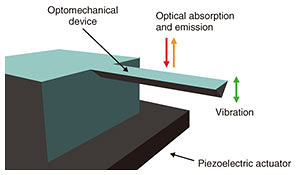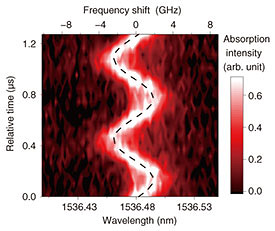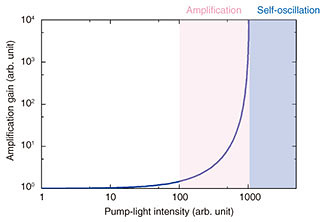 |
|||||||||||
|
|
|||||||||||
|
Feature Articles: The Forefront of Nanomechanics Research Vol. 20, No. 4, pp. 49–53, Apr. 2022. https://doi.org/10.53829/ntr202204fa8 Development of an Optomechanical Device with Extremely Low Optical Energy LossAbstractOptomechanical devices have attracted attention as functional devices that add mechanical degrees of freedom to optical devices such as light-emitting ones. Optomechanical devices have mainly been constructed of semiconductor materials that are easy to microprocess, but NTT laboratories are developing optomechanical devices composed of rare-earth materials that have optical properties superior to those of semiconductors. In this article, we introduce research results on an optomechanical device with extremely low optical energy loss, which was achieved using erbium ions with a luminescence lifetime much longer than that of semiconductor materials. Keywords: erbium, strain engineering, optomechanical device 1. Optomechanical devices using erbium ionsA cantilever structure made of a thin semiconductor film such as silicon is a nanomechanical device*1 that uses the vertical vibration of the film. Such devices are used in a wide range of applications, such as for micro sensors used in mobile terminals and cutting-edge analytical equipment. These devices are roughly divided into electromechanical devices that can be electrically operated and optomechanical devices that can be operated by light. In the latter, the interaction between light and mechanical vibration can be enhanced by confining light and vibration in the same region [1]. Therefore, optomechanical devices are attracting attention as devices that enable highly sensitive vibration detection and high-precision vibration control through the interaction between light and motion. The relationship of energy-loss time between light and mechanical vibration is important for optomechanical devices. Energy-loss time refers to the time it takes for light to lose energy and become dark, and mechanical vibration refers to the time it takes for the vibration to lose energy and stop. We can control a physical system with a longer energy-loss time by using another physical system with a shorter energy-loss time. For example, if light lasts longer than vibration, vibration can be used to modulate the intensity and phase of light. In contrast, when vibration lasts longer than light, it is possible to control vibration by using light. In conventional optomechanical devices made of semiconductor materials, the lifetime, or energy-loss time, of light is much shorter than that of mechanical vibration, making it possible to control vibration using light [2], but it has been difficult to control light using vibration. To address this issue, NTT laboratories have developed an optomechanical device in which the energy-loss time of light exceeds the loss time of vibration thanks to the use of erbium ions, which has a significantly longer emission lifetime compared with semiconductor materials [3]. This enables novel applications such as optical amplification and oscillation using mechanical vibration, which were previously difficult to achieve experimentally. Since erbium can absorb and emit light in the communication-wavelength band (about 1.5 μm) suitable for long-distance transmission, it has been applied to lasers and optical amplifiers for optical communication. Therefore, if erbium is used for optomechanical devices, the devices can be operated in the communication-wavelength band. Also, as mentioned above, erbium is a material with a long emission lifetime and low energy loss, so the use of erbium is expected to save energy in such devices.
2. Modulation of erbium resonance wavelength by mechanical vibrationMany optical materials (e.g., semiconductors and erbium) produce strong light absorption and emission at resonance wavelengths. The resonance wavelength depends mainly on the properties of the material and on external factors such as electric and magnetic fields. In the optomechanical device used in our study, strain can be introduced as an external factor by mechanical vibration. Optomechanical properties, in which the resonance wavelength of erbium is modulated by distortion, enable vibration detection by using light and light control by using vibration. However, the optical resonance of erbium is not very sensitive to strain because the energy levels that contribute to resonance are present in the core region of the atom. Our optomechanical device can locally apply large strain by using the resonance characteristics of the mechanical element. Resonance is a phenomenon in which vibration is amplified at a frequency inherent to the device. Since the quality (Q) factor of the mechanical resonance of our device is 2500, we can introduce a strain approximately Q times larger, that is, about 2500 times larger, than a device without resonance. We succeeded in modulating the resonance wavelength of erbium by introducing a large strain using mechanical resonance. In our optomechanical device (Fig. 1), a large ensemble of erbium atoms is embedded in a crystal. This crystal is milled obliquely with a focused ion beam*2 to obtain a cantilever with an inverted triangular cross-section (length: 140 μm, width: 14 μm, maximum thickness: 7 μm). The device is placed on a piezoelectric actuator and cooled to about 4 Kelvin (–269°C), where a sharp optical resonance of erbium can be obtained. The actuator is then used to excite the vibration of the device in this cryogenic environment. When an alternating current (AC) voltage is applied to the actuator, the actuator vibrates at that frequency. The chip of the device installed on the actuator also vibrates in the same manner, but when the frequency of the AC voltage matches the resonance frequency (1.57 MHz), mechanical resonance causes displacement of about Q times in the mechanical element. This vibration can be measured by irradiating a detection laser (wavelength: 633 nm) to the device and detecting the reflected light with a Doppler interferometer (Fig. 2(a)). During mechanical resonance, a large strain is applied near the central surface of the cantilever, and this strain acts on the erbium ions embedded in the crystal. We conducted an experiment to confirm the mechanical properties of the device then evaluated the optical properties by irradiating a tunable laser (wavelength: approximately 1536 nm = 1.536 μm) for optical excitation. Figure 2(b) shows the relationship between the laser wavelength and light-absorption intensity when the optomechanical device is not driven. A sharp peak based on the optical resonance of erbium can be observed at around 1536.48 nm.
One of the key features of this device is that the lifetime of erbium emission exceeds that of mechanical vibration. Figure 2(c) shows the experimental results that confirm this. In this experiment, the excitation of vibration by the actuator and the excitation of light by erbium were stopped simultaneously at a certain time, and from that moment, the intensity of light and amplitude of vibration were measured to determine how much they attenuated over time. The results indicate that the energy-loss time of light is sufficiently longer than that of vibration. Such a relationship cannot be achieved without the use of optical resonance, which has a very low energy loss, but we succeeded in achieving this by using erbium ions with better optical properties than conventional semiconductor materials.
Another important feature of this device is that the optical resonance of erbium changes in accordance with the vibration displacement of the device. This was confirmed through experiments to evaluate how the optical resonance in Fig. 2(b) responds to time when the frequency of the voltage applied to the actuator matches the mechanical resonance frequency (1.57 MHz). The results are shown in Fig. 3, where the horizontal axis represents the wavelength of light, the vertical axis represents time, and the intensity of color represents the optical-resonance intensity of erbium. We can see that the optical resonance of erbium shifts in accordance with the period of mechanical vibration (0.64 μs = reciprocal of 1.57 MHz (resonant frequency)). The amount of shift exceeds the optical linewidth of erbium, which confirms that erbium emission can be controlled using strain.
3. Amplification and oscillation of light using mechanical vibrationThe above phenomenon, in which the resonance wavelength of erbium changes in response to vibration, is based on the nonlinear interaction between light and mechanical vibration. This nonlinear interaction is what makes it possible to construct nonlinear optomechanical devices such as optical amplifiers. Figure 4 shows how the emission intensity of erbium is amplified in accordance with the pump-light intensity when pump light is introduced into the optomechanical device. In this simulation, we used the magnitude and loss time of the interaction between light and mechanical vibration obtained from the above experiment. When the frequency of the pump light matches the sum of the resonance frequency of erbium ions and the mechanical resonance frequency, the light can be amplified and oscillate. This is because the energy of the pump light is distributed to the energy of optical resonance and mechanical resonance under such frequency-matching conditions. However, the energy distributed to mechanical resonance is lost much faster than that of optical resonance, so the energy can be selectively supplied to the optical resonance. This is a unique phenomenon that can be achieved with this optomechanical device, in which the lifetime of light is much longer than that of mechanical vibration. Such a mechanically induced optical amplifier formed on a chip is attracting attention as a compact and energy-saving optical device. Since the gain obtained depends on the structure of the mechanical properties and Q factor, even higher gains can be expected in the future by optimizing the device structure.
4. Summary and future outlookThis article introduced an optomechanical device we developed using rare-earth materials. By embedding erbium ions in a crystal, which have a lifetime longer than that of mechanical vibration, we have shown that optical resonance-frequency control and signal amplification can be achieved using this optomechanical device. We conducted our experiments in the very low temperature environment of –269°C. For future work, we will improve the materials and structures for operation at which nitrogen is in liquid phase (–196°C) and develop devices that can be practically applied. The operating frequency of the present device is about 1 MHz, but we aim to achieve high-speed operation in the GHz range by miniaturizing the device. If such high-speed operation can be attained, applications to optical-control technologies such as modulation of a laser light and wavelength multiplexing should be possible. Erbium is a material that can be used not only for optical communication but also for quantum information. Therefore, application of optomechanical devices containing erbium ions to quantum information technology is expected in the future. References
|
|||||||||||
















